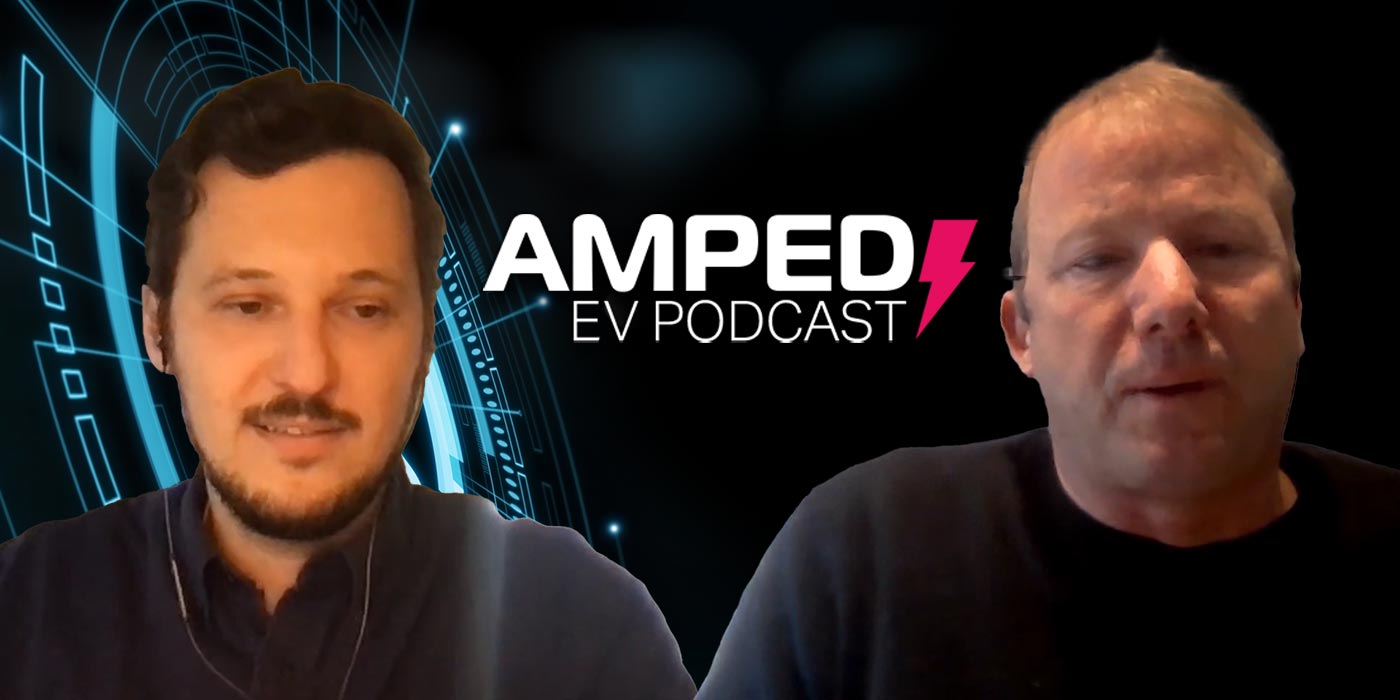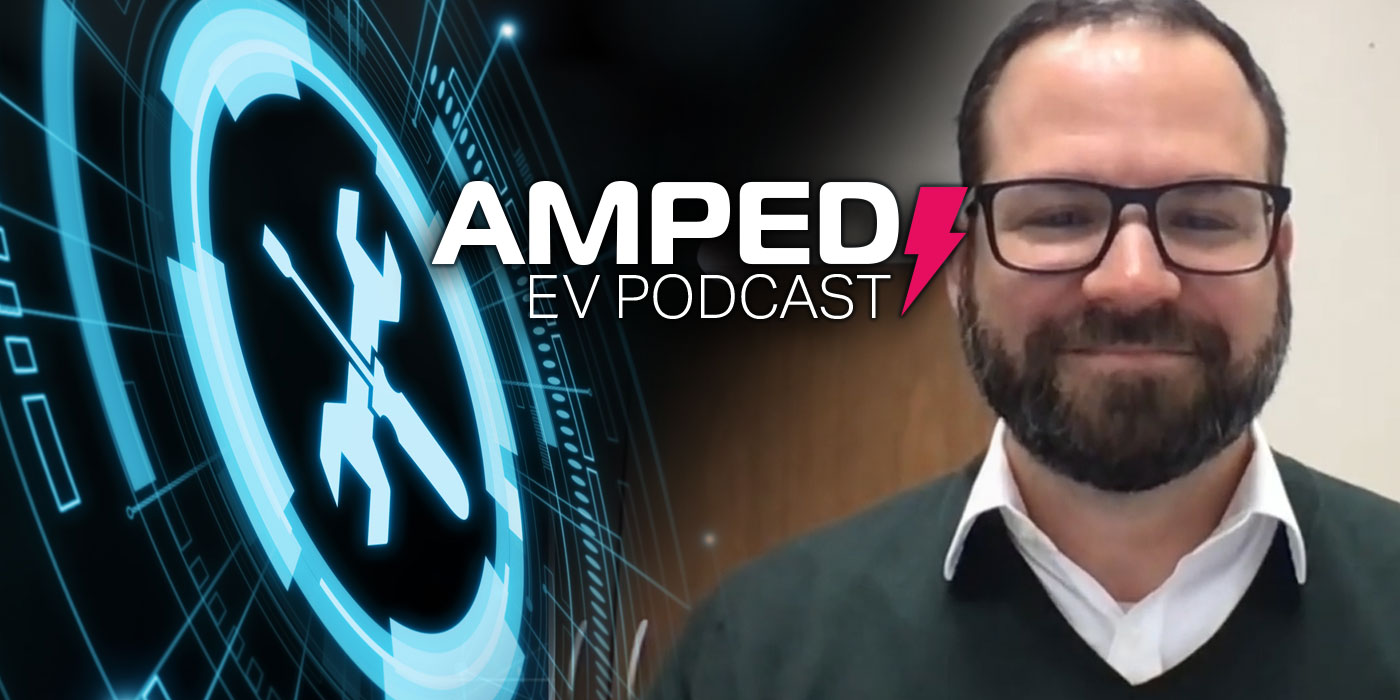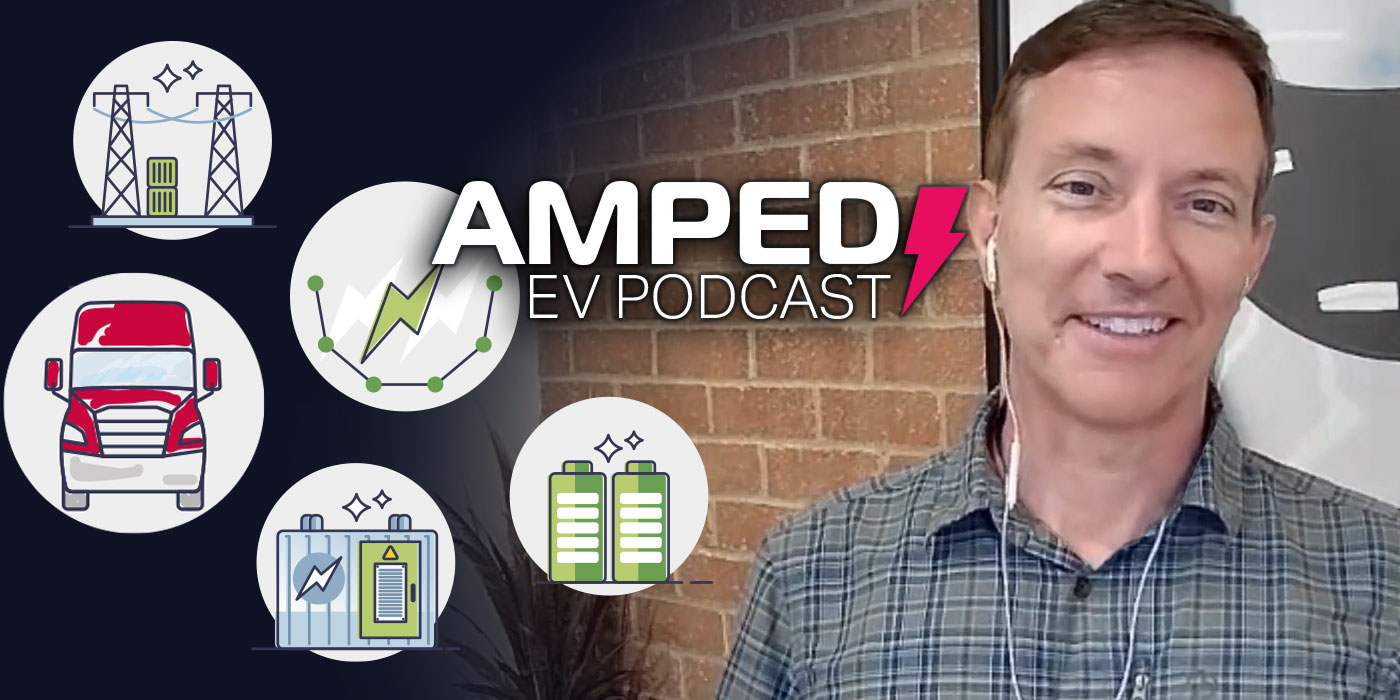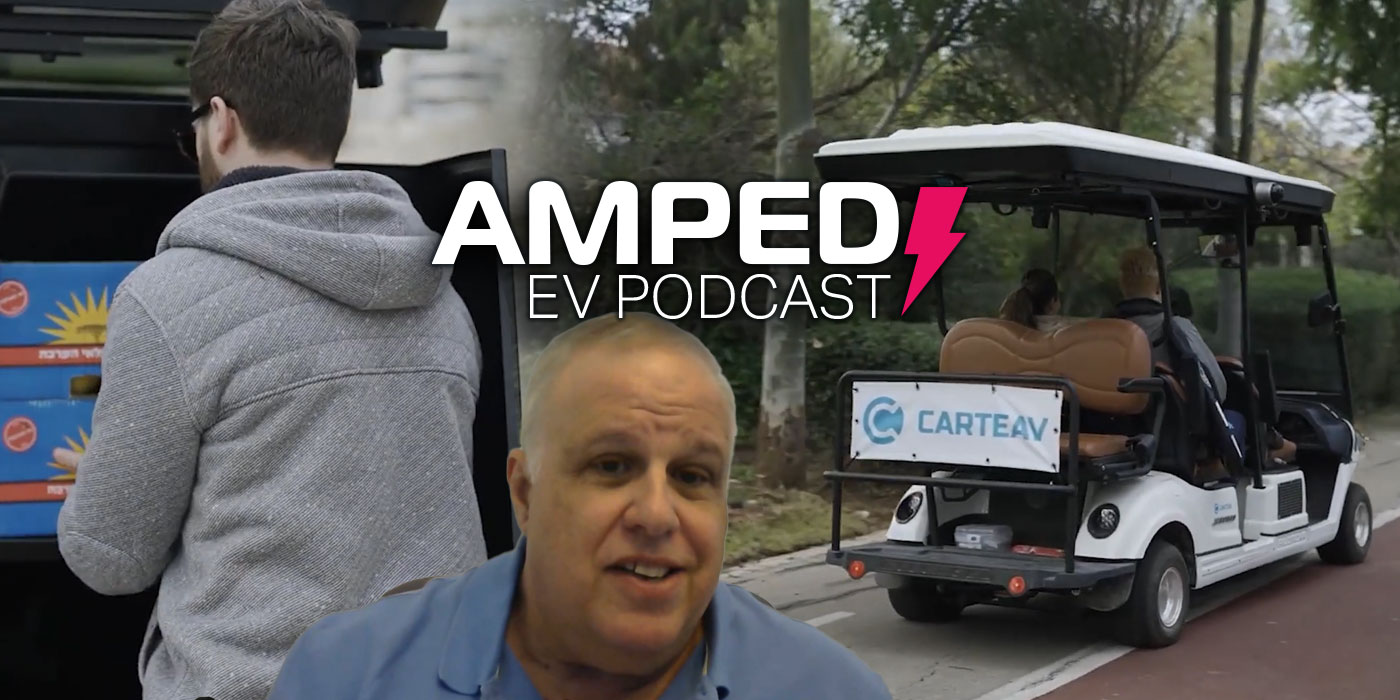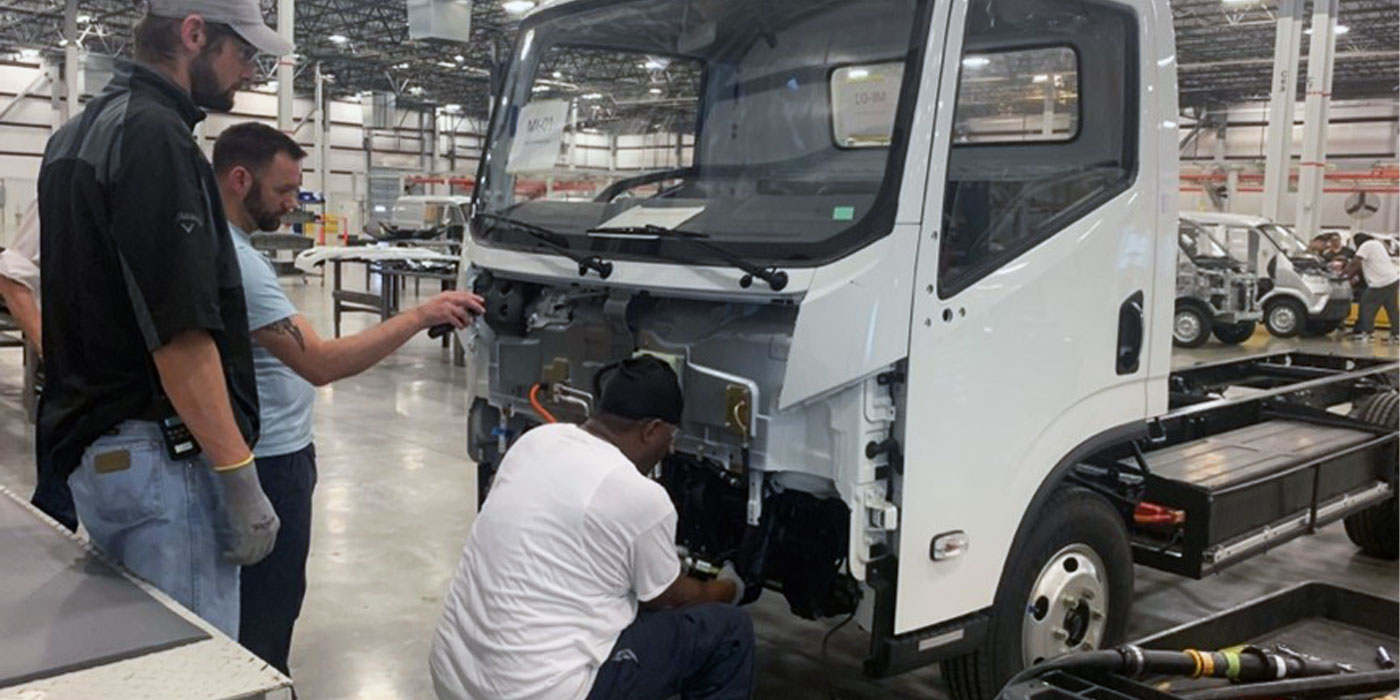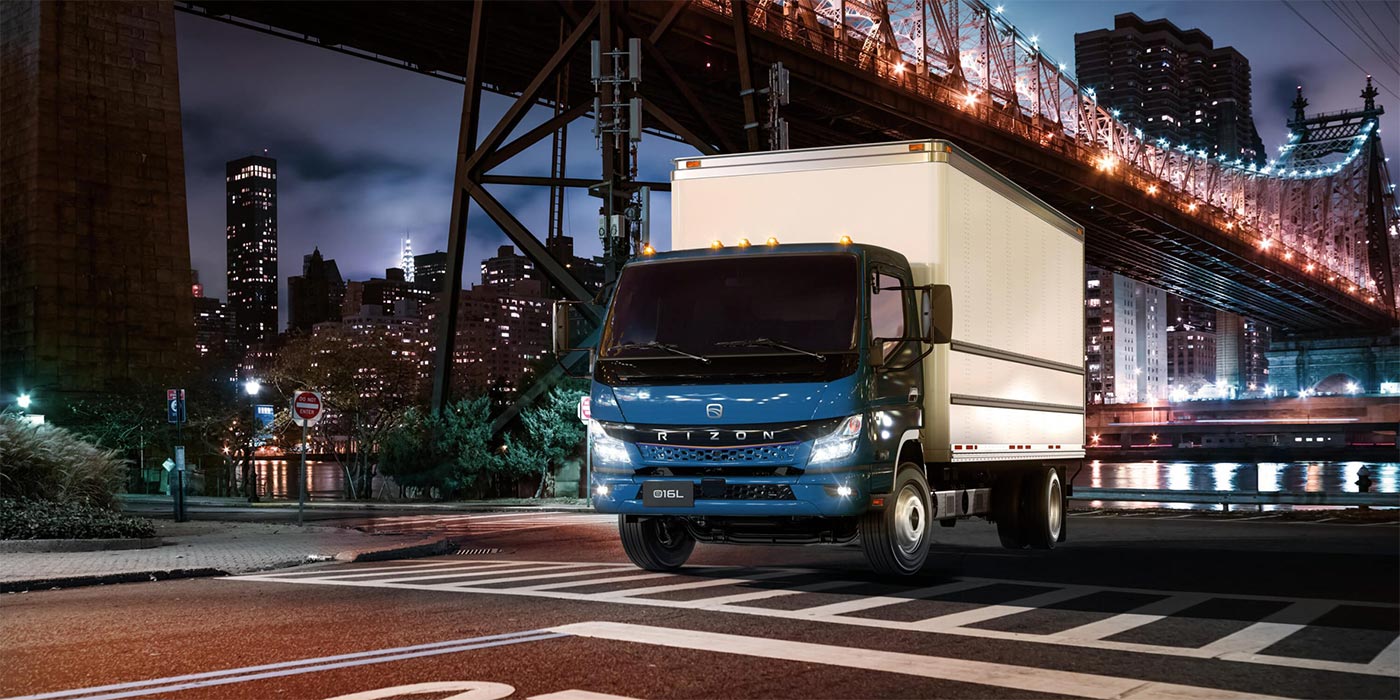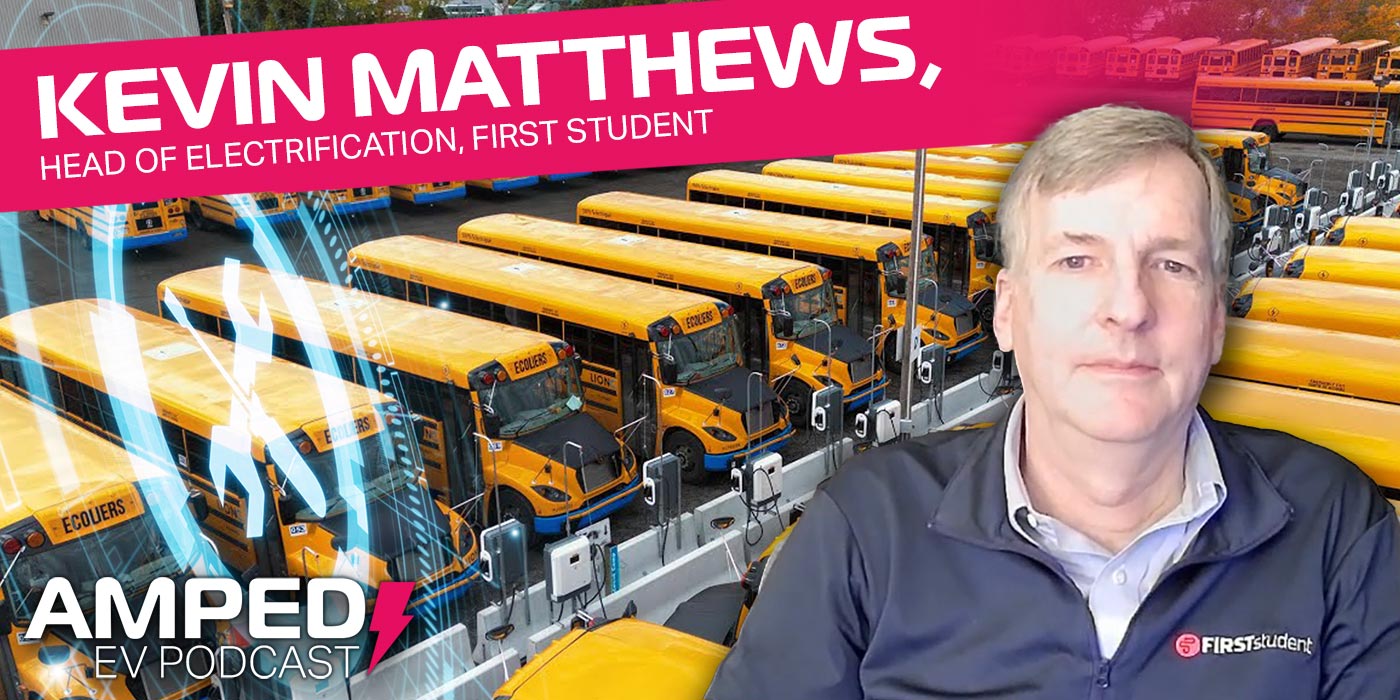What do you do when you’re given a $1 million check to find an integrated Class 3-5 EV chassis? If you’re working with The Shyft Group, you ask for $8 million more to develop one yourself.
The Shyft Group is betting that by designing and manufacturing its own Class 3-5 Blue Arc chassis and bodies in-house from the ground up, using well-respected component suppliers like Dana for eAxles and Hendrickson for single leaf-spring suspensions, the company can lead the pack when it comes to electrifying commercial fleets. Considering the company recently secured an initial pre-order of 2,000 units from one of the largest dealer groups in the Carolinas, the strategy looks to be coming up roses.
To tell us more about designing and manufacturing an all-electric delivery walk-in van in-house, we invite Daryl Adams, The Shyft Group president and CEO, onto the show.
Want more Amped EV podcast? Click here.
Here’s a transcript of the show:
David Sickels: Hello. Welcome to the Amped EV Podcast. My name is David Sickels. I am the editor for The Buzz.
Jason Morgan: I am Jason Morgan, content director for Fleet Equipment. I’m amped.
David Sickels: I am also amped.
Jason Morgan: Why are you amped?
David Sickels: Because I am feeling a… shift in the EV winds here. I’m talking about the Shyft Group. We’re talking with Daryl Adams, The Shyft Group president and CEO, today. He wants to talk to us about two things.
First off, he’s got class three through five Blue Arc chassis and bodies that they are designing from the ground up. He has a lot of really interesting ways that they’re planning to distribute and use those.
They also have the Blue Arc Power Cube, which is a mobile, non-permanent charging station that people can use. He described it to me as a bridge, if you will. A fleet could install this and use this while they’re still trying to get their permanent infrastructure set up.
David Sickels: Daryl, thank you so much for joining us today. I really, really appreciate your time here. I want to just get right into it, get started talking about your class three through five Blue Arc chassis and bodies that you are building and designing really from the ground up.
What were your primary goals in designing these vehicles, and then what would you say makes these vehicles different from other all-electric offerings out there?
Daryl Adams: Sure. Yeah, David, when we looked at this, in the typical space that we’re in, in delivery vehicles, we would be agnostic to the ICE chassis. Whether it was supplier A or supplier B, our OEMs would ship them to us. We’d build on them, and the vehicle would move on.
But we wanted to be in the forefront of EV. We were excited about it. When we actually looked out to see if there were any chassis, we didn’t find any. We couldn’t find any. We looked hard. We actually have a joke internally where we gave my biz development person a million-dollar check to go find a chassis. We would offer a million-dollar check for a chassis, and they would ask us for $8 million more to develop the chassis for us.
We looked at that, and then we sat back and said, “As a company, the Shyft Group, we’ve been building motorhome chassis for almost 50 years. The company was founded on building fire truck chassis. These are all custom. We’ve been building bodies at the TeleMaster side for 50 years.”
So when we couldn’t find it, I got the group together. We have great engineers here at the Shyft Group. You got the business minds together. We put a proposal and took it to our board in early of ’21.
We also had some influence from our customers. Two of our customers came to us and said, “Look it. We really need you to get involved.” We tried to hold our ground and say, “We want to stay agnostic. That’s what we’re good at, and we understand that.” They said, “Well, but you do make fire truck chassis, and you do make motorhome chassis.” They asked us to get involved, because they didn’t feel they were getting what they needed.
We know what our customers need. We know what the step height should be. We know what the door width should be. We know all the factors that go in. What’s important, that people don’t think about, is they want the vehicle to perform the same and operate the same. When it comes into their distribution center, if you have a different deck height or different step bumper height, it doesn’t fit their infrastructure. So the vehicle … We went under the mindset that we can’t ask all of our customers to change their infrastructure to match our vehicle. Our vehicle should be the same, to match their infrastructure. That was where we started on a base.
Then we wanted to make sure the batteries were protected. That’s why we started with a brand-new chassis from the ground up. Our batteries, and all the high voltage cables and brake lines and everything, run between our two frame rails. We can accommodate all three of our battery sizes within that same window.
We saw a lot. We learned a lot. We went to a lot of shows and saw a lot of PowerPoint presentations. When we developed ours, we said, “Look it. This is important.” Vehicles … They do get in crashes. They do get banged up. They’re on the road that often, they’re going to have some problems. So we wanted to make sure that we protected the batteries. That was the key driver behind all brand new, ground-up.
Now, what that allowed us to do also was break the paradigm from our typical suppliers. We were able to work with new suppliers, like Dana, who does our e-axle. We worked with Hendrickson. Great partners, but we wanted something unique for this, so we actually have a brand-new suspension. It’s a single-leaf spring from Hendrickson on the rear, which gives you less weight.
It’s all about taking weight out of the product. We actually have taken 2,000 pounds out, by the way, from our traditional ICE vehicle to the EV vehicle. That’s going to help with the range.
Then we have … Modine’s helping us with the cooling systems. Proterra is a U.S. manufactured or assembled battery pack builder. We wanted to make sure that we align … We have Akebono brakes. We have Bosch. These are all proven automotive and higher vehicle class suppliers that are world-class. That was important to us.
We put all that together and took it to our board in June of 2021. We announced it at our analyst day. By the end of the year, we actually had a operating chassis with the software.
We own the software. The Shyft Group owns the software. We thought that should be the proprietary product or technology that we have, so that if we have a customer that says, which they do, they don’t want …
These EVs have a lot of torque, but they want the vehicles to start up very similar to an ICE vehicle. So we can regulate, through the computer system, zero to 40, or zero to 30, or zero to 60, or maybe from 30 to 60. We can also have that torque curve change, so we can adopt whether they’re getting on a highway, or if they’re in a neighborhood subdivision. They don’t want to be speeding through the subdivision, because it’s their brand.
That’s, to me, the exciting part of owning the software is we can work with them, instead of going to somebody all the time and trying to get a canned system.
Jason Morgan: Right, right. Even that, the regen power and how much regen breaking power you have, so you can enable some of that more comfortable one-pedal driving, instead of getting that jerky golf cart operation as well.
Daryl Adams: Exactly. I think it’s important to understand that we didn’t feel a canned piece of software is going to work for every application, Jason, to your point, where maybe you’re in the mountains, or maybe you’re on a flat surface, or maybe you have a lot of payload.
We can actually tune it to the drivers. If the drivers don’t like it, we can also tune it to that, because we’ll be remote monitoring all these products as well.
Jason Morgan: Right, right. A lot to unpack there. One thing I do want to note, though, because this space is picking up a lot, we’re talking to … We’re seeing a lot of EV announcements.
I want to make sure I get this right, because you had a relatively staggering announcement here earlier of a pre-order of 2,000 all-electric delivery vans from the Randy Marion dealer group in the Carolinas. You got to love seeing that number too, bringing out a product and seeing that kind of support.
But then as you know, as these roll out, how do you go about working with them to make sure they understand everything that comes along with the electric vehicle sale, then support their customers and so on and so forth?
Daryl Adams: Yeah. Actually, it’s a very good question, because this is going to be new to everybody. I’m sure they’re working with some of their class two OEM suppliers of vehicles, GM or Ford or whoever they’re getting them from. So they have some knowledge of the EV space.
But in our system, back to the first question, just a little catch-up, we also developed ours to be an 800-volt system. That allows us to charge faster and take weight out of the cables. The high voltage cables, the higher voltage you have, the smaller the cable can be.
We’re talking to Randy and his team, Randy Marion, the dealer group, about how to maintain the vehicles. They are super excited. They’ve looked. They’ve purchased other startup EV products. They were super excited. They wanted to make sure they got in upfront.
They have a lot of customers asking. They do a lot of work with the FedEx ground fleet customers, which are private companies or entrepreneurs. He has great relationships with them all over the country. It’s not just in the Carolinas. He sells vehicles all over the country. He sees them.
We believe we’re going to launch this in the summer of next year. June, July sometime we’re going to have the soft launch. We’re going to start a slow ramp because this is also new to our operators. You have high voltage. These batteries, they’re very powerful. So we want to make sure that we crawl, walk, run through the ramp-up.
We think we’ll get maybe 500 next year, in 2023, so the second half of ’23. Then we’re looking to get 1,000 to 1,500 in 2024, and continue to ramp it up as the demand comes. Now, if the demand comes faster …
This 2,000 order that you referenced, Jason, is over a number of years, but he just wanted to get in front of it so he can get the first ones. We do have a dealer agreement with him.
Now, we understand also that these vehicles are going to be sold around the country. We also understand, other dealers that we’re working with right now to sign up will have vehicles around the country. So we are actually working with a couple right now. We’re in talks with two service organizations that have fleets that will be out on the road.
This is a work truck. These trucks need to operate. They can’t be sitting on the side of the road. So if there’s an issue, we want to make sure that we can get quick response to the vehicle, help the operator. Is this something simple? Do we have to take it back? So we are working to establish our service network too, which is going to be … To us, it’ll be very important as the vehicles get out into our customer’s hands.
David Sickels: Excuse the pun here, but I want to “Shyft” over to another one of your products here, the Blue Arc power cube. It doesn’t need to be connected to the grid. Provides three megawatts of onboard power, with level two and fast charging abilities.
What kinds of customers are asking you for this kind of solution? How long does it take to deploy? What does it take on your end to deploy this kind of charging unit?
Daryl Adams: Again, David, when we looked at what was on the market, and talking with our customers … Our customers are saying, “Look. I’d love to buy your vehicle, but I lease my facility,” especially if it’s a contractor, “and I don’t want to pay to get a bunch of new power into my facility.” We heard this a few times, as the sales team and myself were out talking to the customers. The engineers, we went back, said, “Look it. Here’s the problem.” They said, “We got this. Not a problem.”
It’s about the size, just to put it in perspective, of an overseas shipping container. It’s about that size, from 150-kilowatt hours up to three megawatts on it. So we can scale it how however they need it, depending on how many vehicles.
We looked at this as being a bridge. We saw a lot of people had the ones that you could put on a trailer with wheels, and haul it around. That might get you a vehicle or two. We’re thinking that might be with our service network that’s out on the road in case there’s a battery that’s low.
But the main thing with the power cube is it will be dropped at a building. We say it’s remote-controlled. It does have … The first one we did has all the bells and whistles. It’s got a hydraulic system that raises it up. It’s got a hydrostatic transmission that will, or wheels that’ll move it around, so you can get it close to a building. Then we have solar panels on top that fold open. They close for transport. This will actually … You can load it onto a flatbed trailer. That’s how we’ve actually moved it around.
Just to prove out the concept, we took it to Washington DC on a flatbed. We dropped it in the area they allowed us to show the vehicle and the power cube, and pulled the truck out from underneath it. It was up and charging the vehicle. It was really hot days, so we had fans going for us. We let people charge their phones. Once it’s charged, it can be deployed anywhere.
It’s really interesting as the use cases started to, especially when we were in DC … Just think about national disasters like Hurricane Ian. If FEMA had some of these, they could drop them in, and people could charge their vehicles. If you come home from work or a long trip, you go to charge your vehicle, and the grid goes down for some reason, whether it’s a storm, you can’t leave if you have to. Then we started thinking about national parks or state parks, where they don’t have a lot of power going up to that region. We could drop this.
The real benefit that we’re seeing is the buffer that it will create. It can be charged, hooked up into a building. It’ll be trickle charged, if you will. It’s going to be a large trickle, but it’ll be consistent charging off the grid, so that when a bunch of fleet vehicles come back into the depot, and they all want to plug in approximately the same time, you’re going to see spikes on the grid. The spike will be off of this battery that we have in there, and the grid will be consistent at the same level over 24 hours. So you can actually predict your power usage, which seems to be real intriguing to some of the customers that we’ve talked to.
Jason Morgan: I thought the size was interesting, the size of about a shipping container. Because one of the things that I’ve heard in talking more about this with OEMs and suppliers and even fleets, is that even smaller mobile ones, like I was with a larger fleet that was in a larger segment, the class seven, eight segment, they had one electric truck, and they were charging it with a mobile charger unit just because, like you had mentioned, the bridge.
They were working on the infrastructure piece. It takes a lot of time. It takes a lot of money. They wanted to get in earlier, so they had this mobile charger. This larger power cube container size idea is really, really intriguing.
Going back to your software comment earlier then, is this power … Can I serve any vehicle with this? You mentioned people are charging cell phones and stuff. Can I plug any vehicle? Is this a Shyft Group vehicle only? How does that work?
Daryl Adams: No, no. Obviously, if it’s out in the public use, we are working with charging companies that know how to use credit cards and charge people for the power, so you can charge any vehicle with it. It’s not proprietary, but you will need to swipe a credit card to get the power turned on, if it’s in a public use. But we’re thinking more of our fleet customers.
If we sell it to … National disasters, I don’t think we should charge people if they need the power. But if you’re driving up to a national park, or wherever it may be deployed, and you just want to charge your vehicle because you need to do it on your trip, whether you get the power off of the Blue Arc power cube or off of some standalone charger, you’re going to have to pay either way.
It has the flexibility to be, obviously, free, which we’re doing right now. Just to get some cycles on the battery, we have it tied into our building in Plymouth, which I mentioned to you guys, where our innovation center is. We’re letting anybody in the area that wants to park and charge their vehicle, we’ll let them charge.
We want to get cycles on it. We want to test the charger, let the battery drain down and charge it back up, just put it through his paces.
David Sickels: Sure, sure. Obviously, Class 2, Class 3, we’re talking delivery vans, box trucks, that kind of thing. That’s perfect for last-mile delivery. I think a lot of people definitely agree with that. Can you think of other applications that might benefit by using this size of electric vehicle?
Daryl Adams: Yeah, actually. That’s part of the Randy Marion Group. When we met with them, obviously a few times working up to that order, or the pre-order I should say …
Let me just back up and clarify that. The reason we call it a pre-order is, in order for us to sell a vehicle, we need a certificate of certification from the EPA, and in this case, CARB as well, in the Class 3 space. We have received the EPA approval. The vehicle is actually being tested right now by CARB. We expect to receive that in mid-November. Then that order will move from a pre-order to a live order with the Randy Marion Group.
As we were talking to them about the size of the order, they said, “There’s a lot of other vehicles in this space that you’re not talking to.”
They brought up, for example, an HVAC company in New York has a truck out every day just changing filters in the city of New York in HVAC systems. Filters aren’t that heavy. Can you imagine going through a building … The vehicle probably just drives to the building, and parks all day, and they move up and down the elevator, and change out to HVAC filters, and then they go back and come back to the next building the next day. He’s saying there are so many plumbers and HVAC and electricians in the big cities that don’t move, that would really be interested in this type of vehicle. So he actually, that Randy Marion Group actually opened our eyes a little bit to some more use cases that we typically don’t think of.
Then we actually went to our other division, specialty vehicles. They do the service bodies, which are the white … box is on the back with the doors on the side, like a cable TV company, or again, a plumber or electrician. We sell a lot of those to municipalities. We can fit that on the back of this chassis that we have, and have a product available for municipalities as well.
Once we started, similar to the power cube, maybe we should have got out of our wheelhouse a long time ago, with the typical delivery vehicle. But this new one looks a lot better. It’s designed a little bit softer. It looks more like an automotive-style vehicle. So everyone’s excited about the extra use cases that we typically don’t have, which is going to be nice as we continue to grow the company, as we have over the last five, 10 years.
David Sickels: Absolutely. Daryl, this has been really great, really eye-opening. Sounds like you have a lot of really smart people working with you, and you’re really getting into a lot of interesting areas. So I really look forward to seeing how this evolves over the next couple of years or so. Thanks a lot for joining us today.
Daryl Adams: My pleasure. David, Jason, nice meeting you guys.
David Sickels: You too. Okay.
Jason Morgan: All right. I was right to be amped. That was cool. I got three things for you, if I can.
David Sickels: Okay.
Jason Morgan: Let me put you in the way back time machine. I looked this up, because The Shyft Group, I’ve talked with before. I did something with them in early 2021, when they were building out their last-mile offering there, and upfitting those types of vehicles.
It’s funny. I reviewed the interview today. EV was the last question we went in there. The takeaway was, “It’s coming. It’s going to be here. Stay tuned.” Well now, a little over a year, year and a half, later, wow, they’ve really grown. Very cool.
David Sickels: Oh my gosh. Yeah. You’re right.
Jason Morgan: One of the biggest things, like he mentioned, these type of applications are just prime for EV. We just haven’t seen the growth as fast as in some of maybe the class seven and eight segment. You’d think this would grow a little faster. But the things that he called out, work truck spec and expectations, I think it’s taking a long time, or a longer-ish time to work out those details.
He was talking about the frame rail needs, being able to upfit the vehicles. These are specialized vehicles that go into specialized applications, so it’s not a one size fits all kind of, “Here’s a vehicle and here’s your battery options.” You really got to make it so they’re upfittable, and they work for those type of applications. So really see all that work coming together to bring it to the market now.
David Sickels: Yep, yep. That’s important. He was talking about plumbers and HVAC, and different municipalities that might be able to take advantage of this kind of thing. I think that would obviously be a very smart use for this type of vehicle as well.
Like you said, what’s a filter weigh? If you just have a van full of filters behind you, I think you’re going to be okay in most cases.
Another one of my takeaways, they partnered with a lot of very well known companies in the aftermarket space to establish this as really like, “Hey. This is a major player. We’ve got something that we’re really excited about and something that should be …” What are you giving me that look for?
Jason Morgan: You stole my … That was my third one! I thought the same thing.
David Sickels: I think it’s very smart …
Jason Morgan: It is very smart.
David Sickels: … to have that long list of really established players behind this project to say, “Hey. We’re not messing around here. We’ve got people who you know and already trust.” Having that behind them, I think, was a really smart move.
Jason Morgan: Yeah. I like your mind-reading abilities here, because yeah, Hendrickson, Dana. There is a lot new in the market.
David Sickels: Yeah, absolutely.
Jason Morgan: Even the Blue Arc brand is new. But yeah. We’ve seen a trend now of really leaning on those people and companies that have been in the commercial vehicle space, that understand the needs of those businesses and those end users. Yeah. Leveraging that decades upon decades upon decades of knowledge, a really, really smart move.
David Sickels: Absolutely. My very last point, the shipping container-sized charging station. I love his ideas, where you can give this to a fleet as a bridge, while you’re still working on the infrastructure. Like we’ve talked about a million times, it takes way longer than you think it’s going to take to actually get this up and running, this kind of infrastructure for electric vehicles. Then also the emergency situations, with FEMA or at a national park site or something like that, could be really smart. I have not seen one of these at that scale before, so I think that’s going to hit a need somewhere in the market.
Jason Morgan: Yeah. You think about it from a fleet perspective too. Maybe investing in one of those gets you that foot in the door. Maybe you take on two or three electric vehicles and start getting your feet wet with it, start understanding the application before going down the road of full charging infrastructure. Scaling up from a power cube investment then to something that’s going to meet the needs of, if you want to go to 10, 20, 30, 40 electric vehicles.
Jason Morgan: I could see how that would be a little bit more approachable than, “Okay. Well, let me dig everything up now, and put in this now, and then try to figure out what I’ll need five years from now.” I like that bridge concept. That’s really cool.
David Sickels: Well, this was a lot of fun. Thanks, Jason.
Jason Morgan: Thanks for setting that up.






